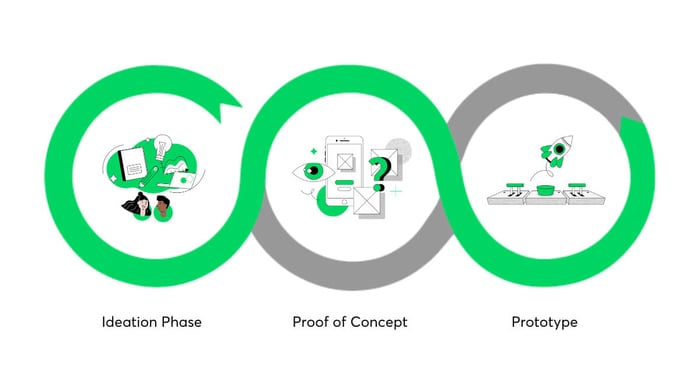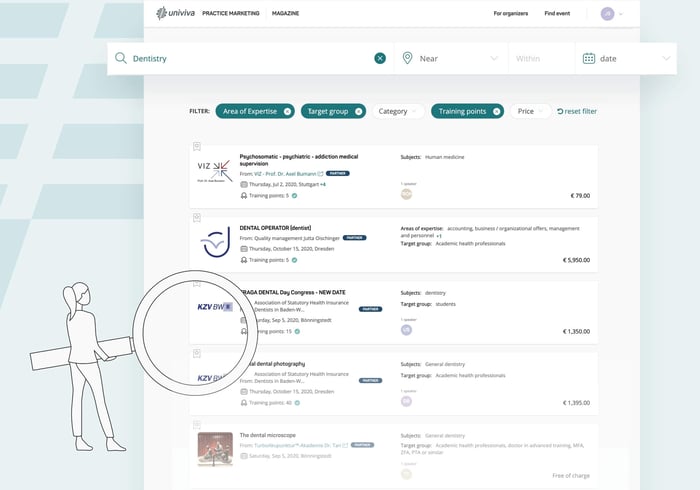What is a Proof of Concept (PoC) in Software Development?
More than 66% of startups fail to return value to investors, according to Harvard Business Review. What are the reasons for such a high failure rate?
Businesses and entrepreneurs often jump straight into product development to get their solutions up and running as quickly as possible. It’s a risky move that may end with failure.
The path to launching a new software product successfully starts with a proof of concept (PoC). It’s a software development testing methodology that helps businesses make rational decisions about the creation of a new software product and define its future. This initial check increases the chances of building a useful solution people will genuinely like to use.
The success of a software tool goes beyond the product’s original idea. If it’s poorly tested and aligned with the market needs, you may end up investing a lot of time and money into a product that may prove to be useless and simply won’t sell. With a proof of concept, you get evidence that your idea is feasible as well as an explanation of how it will work and why it’s worth the funding.
Mục lục bài viết
A proof of concept in software development – definition
In software development, a proof of concept is a verification methodology implemented in the initial stage of the product development lifecycle. The purpose of the proof of concept is to test the validity of the software idea – it’s all about proving that the proposed system, application or product can work in real life before you begin development.
It’s very rare that an initial idea meets the demands of today’s fast-evolving markets. In the end, products need to not only be technically feasible but also designed to solve real-life problems of intended users. If they don’t, they will fail. That’s why for a software development company it’s important to pace the development process by planning it carefully and testing the new idea before actually start building it.
A proof of concept is absolutely essential to define the vision of the final product and its orientation. Because of that, it should involve all stakeholders engaged in the development process. They get together to discuss the limitations, opportunities, and risks, as well as to agree on the direction of the project. It’s an important step in laying solid ground for a smooth development process, testing, modifications, and launch.
A proof of concept can take the form of a document, a presentation, or a demo – at this stage, no coding or design is required. However, the proof of concept should yield thorough documentation of requirements as well as technical specifications. It’s usually done internally or within a narrow stakeholder group when you’re outsourcing.
Often proof of concept is confused with minimum viable product (MVP). However, unlike a proof of concept, a minimum viable product is a workable product with basic functionalities and features.
The benefits of creating a PoC in software development
Millions of companies have new product ideas, but most of them fail. What stands in their way to success? The top two causes of startup failure cited by CBInsights are:
- Lack of funding (or the inability to raise capital)
- Lack of market need
Both of these problems can be solved by starting software development with a proof of concept.
Let’s take a look at all the benefits businesses will get with a PoC:
Assessing technical feasibility
The purpose of creating a proof of concept is to check whether the software idea is technically feasible. A PoC project should involve the development team that not only assesses what is possible and what is impossible but also determines the right technical direction for product development.
Initial verification of market needs
Creating a PoC requires identifying specific problems and pain points you intend to solve with the tool. The goal of this task is to ensure that the product isn’t detached from reality and brings actual value to end users. The testing stage that is also part of this iterative process will indicate whether you are on the right path or not.
Understanding product limitations
Creating a proof of concept in software development will help owners understand the limitations, advantages, and disadvantages of their product idea. During the process, they will be able to discover the different options and choose the best direction for software development.
Making rational budget decisions
Making the most of investors’ funds is crucial to launching a new product. With a proof of concept, businesses can understand their budget requirements and know how they spend the money. They can avoid a horror story in which all the capital they’ve raised is spent on a full-fledged solution that the target market eventually finds useless.
Having a reason-to-believe
Convincing potential investors that your concept is valid and worth their money requires more than enthusiasm. The proof of concept explains why and how your idea will work. It’s a piece of successful proof that will convince even the most skeptical investors and will help you negotiate your terms with other stakeholders.
Accelerating the release
By creating a proof of concept you establish a plan of action for the creation of your new solution. The process helps you verify if you have picked the right workflow and adjust it wherever necessary. By choosing the right path at the outset, you avoid surprises at later stages of the process, learn the risks, and allow yourself to prepare to mitigate them accordingly.
Creating a proof of concept – key steps
Creating a proof of concept in software development should yield detailed documentation describing the requirements of the project, its objectives, and the process and roles assigned to every stakeholder. This will be a detailed document that describes the creative process from early version to deployment.
There are five steps to creating an effective proof of concept.
Step 1: Define the need
When a product idea is born, it’s likely based on assumptions. This point is about finding evidence to validate these assumptions by identifying real-life problems that the software will solve. If you skip this step, you may end up with a working tool that serves no purpose. Talk with the target audience to receive valuable feedback and identify the needs and pain points that you are about to solve.
You may want to answer and document the below questions:
- What are we trying to achieve? What’s the added value?
- What criteria will define the success of the software product?
- What is the timeframe?
- What resources do we have?
- What should be the workflow?
- Is there a comparable solution?
Step 2: Ideate the right solution
Brainstorm the potential solutions to the problems and pain points with your development team. There will likely be different ways to solve these issues. Map the solutions taking into account factors such as your budget and timeframe. Also, take into account the competition – what they already offer and whether you can build on that.
During this ideation process, you may hear something that will surprise you, but you can also be surprised by what you don’t hear. At this point, some of your guesswork will be clarified. This discussion should involve a technical expert who will decide on what is possible and what isn’t.
Step 3: Create a prototype
Once you’ve established the right problem-solution scenario, create a prototype of your tool. Depending on the nature of the product, this could be a mockup, a wireframe, or a simple sketch. It should demonstrate the proposed workflow, envisioned features, and the basic UI/UX.

Step 4: Test the prototype and gather user feedback
The purpose of creating a prototype is to show it to the target audience and gather feedback. While the previous stages would be primarily done internally, this stage is about showing it to potential users and stakeholders to understand whether it has the potential to succeed on the market.
Throughout the process, you will discover the true advantages of your tool and see how intuitive it is. The testing process may also reveal features you had overlooked. Use this valuable feedback to modify the tool accordingly. You may repeat the process until you arrive at a satisfactory version of your software product.
Step 5: Create a roadmap
In the final step, collect all the information you’ve gathered throughout the process and document it in a roadmap. It should outline the step-by-step process for developing the solution and clearly present the goals and objectives. Include all the learnings and recommendations for improving the software development. This will be your bargaining chip for potential investors and a manual for building the product.
Proof of concept examples
One of the biggest PoC examples is Walmart’s application of blockchain technology to improve the traceability of products in the food supply chain. Together with IBM, its technological partner, the company ran two different proof of concept projects: one focused on tracing mangos in the U.S. stores and the other on tracing pork in China.
The proposed, blockchain-powered solutions worked, allowing Walmart to speed up the tracking process. In the event of problems, Walmart could quickly discover the origin in a matter of seconds. Although the idea was technologically feasible, skeptics criticized it for relying on data input by humans, which in their view creates room for error or fraud. The idea behind introducing this solution was to be able to quickly react to outbreaks of food-borne diseases.

Online courses platform by Naontek.
Naontek, a German startup, came with a brilliant idea to create a digital point of contact for the whole healthcare community in the country. They intend to fill the technological gap in the industry by introducing an educational platform for medical professionals, powered by software expertise, and fill the technological gap in the industry by introducing easily accessible digital products and services. To ensure that the creation of the product was feasible and that the market really needed it, they decided to conduct a robust proof of concept.
“Once we started to structure the way we do tech grooming in more detail and how we build proof of concepts, we started delivering the product in the shape we wanted it to have.”
Florian Eßer, Vice President Product Development at Naontek
The process focused on understanding target audience, business needs, and technical sides of the project. Consequently, the company was able to comprehend the needs and challenges of the product development quickly.
In the first 12 months of operation, univiva proved to be a particularly successful launch the platform attracted approximately 20000 users registered, and about 6000 added courses.
Creating a PoC for your new software product
A proof of concept in software development is about validating the idea behind the product at the very beginning before you start raising funds and building it. This initial check is vital to ensure the tool can be built from the technological perspective and to identify expectations and potential risks that may occur in the software development lifecycle that your development team will need to deal with.
It’s the first step businesses can make on the journey towards creating a successful and useful software product. Software development services can assist you in verifying your business idea and provide you with experienced developers as well as product managers that will make sure to bring a successful product into life.











